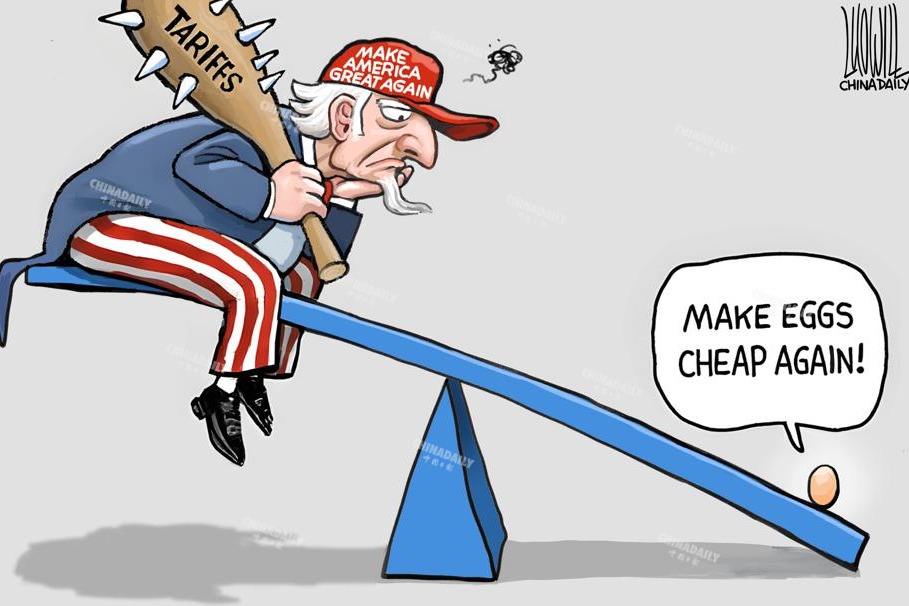Developing new quality productive forces


The resolution on further deepening reform to advance Chinese modernization, which was adopted at the third plenary session of the 20th Central Committee of the Communist Party of China, reiterated the significance of cultivating new high-quality productive forces. It underscored the need to enhance institutions and mechanisms to promote the growth of these new quality productive forces in alignment with local conditions. Furthermore, it emphasized the redirection of diverse advanced production factors toward the advancement of these new high-quality productive forces.
New quality productive forces represent a leap in productivity, as they help create new economic growth drivers amid the fast-changing global landscape and the economic challenges faced by China. Hence, the development of new quality productive forces is necessary for promoting high-quality economic development and achieving Chinese modernization.
The new quality productive forces theory enriches the traditional economic growth theories, which emphasize the importance of factor inputs (including capital, labor and land) and total factor productivity for economic growth. And the development of economic growth theories will help us better understand total factor productivity.
Total factor productivity primarily refers to technological innovation; it encompasses all factors influencing production — capital, labor and land as also technological innovation, institutional environment and human capital. The new quality productive forces theory, based on China's economic practices, deepens our understanding of total factor productivity both at the micro and macro level.
Formed through practice, the new quality productive forces theory provides impetus, support and guidance for high-quality development. In this fast-changing era marked by technological and industrial revolutions, the development of new quality productive forces will accentuate the advantages of China's socialist market economy, boost demand, strengthen industrial systems, and cultivate skilled workers and entrepreneurial talents, while expediting the transformation of these comprehensive advantages into new comparative advantages.
New quality productive forces represent a departure from traditional economic growth models. The development of new quality productive forces is characterized by high-tech, high efficiency, and high quality, with increasing total factor productivity being key to this development.
Continuously improving total factor productivity, introducing new production factors and upgrading traditional production factors are three crucial factors facilitating sustained growth. Studies show that the basic reason for the different growth rates of developed economies after their per capita GDP exceeded $10,000 has been the difference in their total factor productivity.
As such, to ensure the smooth development of new quality productive forces, it is necessary to continuously improve total factor productivity, introduce new production factors (such as data), and upgrade traditional factors. And to fulfill those conditions, China needs to increase investments in high-tech R&D to, among other things, improve the R&D structure.
Generally, in the first stage of economic development, the primary sector's value added contribution to the economy declines and that of the secondary sector increases while the tertiary sector begins to develop. Concurrently, the workforce in the primary sector declines, whereas that in the tertiary sector increases.
In the second stage of economic development, value added by both the primary and secondary sectors declines, while that of the tertiary sector continues to rise. Similarly, the workforce in the primary and secondary sectors decreases, and that in the tertiary sector increases.
And in the third stage, the value-added shares of the primary, secondary, and tertiary sectors stabilize, as does the distribution of the workforce among them. As for the growth rates of the three sectors, the primary and tertiary sectors generally grow at a slower pace than the secondary sector. From the early stages of reform and opening-up to the 18th National Congress of the Communist Party of China in 2012, the Chinese economy completed the first stage of economic development.
Since the 18th Party Congress in 2012, the economy has been transitioning to the second stage of economic development. To sustain the development, it is essential to ensure high labor productivity across the primary, secondary and tertiary sectors, upgrade the secondary sector through innovation while maintaining its growth rate within a healthy range, and developing modern services to achieve a high growth rate in the tertiary sector.
However, China's overall development must be accompanied by the development of all regions. Certain regions in China have developed before others, but as the development in these regions reaches a certain stage, growth rates tend to slow down. To realize sustained development, therefore, the authorities need to first develop underdeveloped, less-developed and rural areas, for which institutional changes — specifically, in terms of production relations — such as building a unified national market are necessary.
The development of new quality productive forces and sustained economic growth can also benefit from the smooth flow of production factors and improvement of factor efficiency.
Economic growth is driven by domestic demand (consumption and investment) and external demand (imports and exports). So it is necessary to boost external demand, because the contributions of imports and exports to economic growth have been declining. And that can be done by developing new quality productive forces.
It is necessary, therefore, to enhance China's technological innovation capability to promote sustained growth of total factor productivity and maintain healthy GDP growth, develop the digital economy by leveraging data's role in driving economic growth, expeditiously build a modern industrial system to boost labor productivity, establish a unified national market and facilitate balanced regional development, and vitalize rural areas to narrow the urban-rural gap.
It is necessary to expand high-level openness to gain new comparative advantages, strengthen the financial system and address the financing difficulties faced by Chinese enterprises, focus on increasing disposable income of the people and raise its proportion in GDP, and build a workforce that would bolster the development of new quality productive forces.
The author is the director of the Center for Management Science, Peking University. The views do not necessarily reflect those of China Daily.
If you have a specific expertise, or would like to share your thought about our stories, then send us your writings at opinion@chinadaily.com.cn, and comment@chinadaily.com.cn.


































